
|
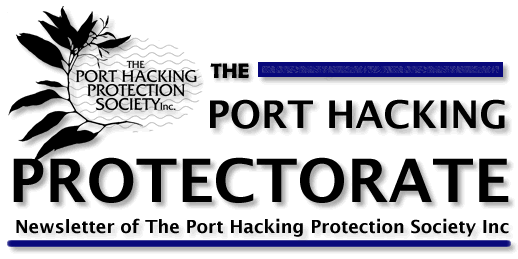 |
March 1998 |
|
Editorial
More Effluent into Port Hacking?
New works at Bundeena - more effluent for Port Hacking. A community confused and angry. Hardline engineers. Budgets allocated and time schedules set and no way back. These seem to be the ingredients for current road and drainage works being carried out in Bundeena. |
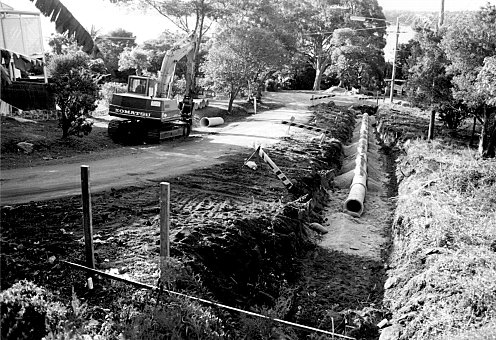
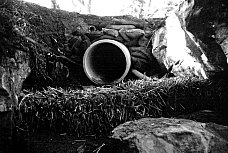  |
Winding its way between the homes lining Gunyah Beach foreshore in Bundeena is (was!) a pot-holed, approximately single-lane, unkerbed and unguttered street. The street starts its life at its eastern end called The Avenue, becomes The Lambeth Walk, and ends as Neil Street.
These streets were remnants of a decision made by Sutherland Shire Council a few decades ago when it had scant money to pave and gutter all streets adequately and so laid tar over approximately the centre of roadways wide enough for the passage of one car.
For years some residents in the street have been grumbling and activating for Sutherland Shire Council to repair the road surface and fix up the drainage in these streets. Council finally allocated the funds, drew up the plans and started work.
Many residents are now reeling with shock as they watch the scope of the works being undertaken. Dozens of huge drain pipes have been trucked into Bundeena. Thousands of tons of soil have been removed from the area into another part of Bundeena where they are being stockpiled at the base of ancient angophoras that are choking as the soil compacts around their root system. Sediment from the stockpiles is seeping into existing channels. Children think the stockpiles are fantastic funparks. They add to the dissipation of sediment by building bike ramps, castles, "slippery dips" and other "creations".
At a hastily convened residents' meeting, questions were asked about the ramifications of the work. Residents sent letters to Sutherland Shire Council detailing their concerns. Sutherland Shire Council is adamant that plans for the street works have been public for some time and have been made available to local community groups. Judging by the confusion and anger of many residents, communications between residents and Council have gone wrong.
The local Progress Association organised for a Council officer to address a public meeting on 7 March 1998 to explain the rationale for the works. The officer revealed an interesting mix of Council thinking. For example, on the one hand, the officer argued that by taking away the current dirt shoulders on the roads and replacing them with a variety of styles of guttering (depending on the deemed requirements of the streetscape), the load of sediment that would otherwise come from the dirt shoulders would be reduced. On the other hand, he made a tacit denial that the addition of impervious surfaces and piped, rather than filtered, drainage would increase surface runoff and the capacity of the runoff to carry more sediment and nutrients into Port Hacking. This in spite of several reports from various government agencies (including Sutherland Shire Council) that detail the detrimental impact on the environment of increasing the number of impervious surfaces.
The officer was questioned why no trash racks, gross pollutant traps, wetlands or sandfilters were being installed in the drainage works. He responded that these types of works were being carried out in catchments of the Shire which have been targeted as "high priority" areas. Since Bundeena is a residential area, such works are not considered necessary. This is in spite of the fact that several studies have shown that Bundeena streets carry a high nutrient level because the area is unsewered. This point was made to the officer who responded that the high nutrient load problem will be rectified when Sydney Water finally connects sewer to Bundeena. Since this likelihood is several years away, the foreshore and beaches of Bundeena, and the visitors to Gunyah and Jibbon beaches will, presumably, simply have to put up with the nutrient and sediment load and the effects of that increased nutrient and sediment load.
Several times during the meeting, the issue of pedestrian safety was raised. Many parts of the street are narrow and it is hard to accommodate both pedestrians and cars. Speed retardation methods and footpaths were suggested. The Council officer repeated several times that if residents were keen to see the removal of vegetation for footpath construction purposes, he would look into how it might be done. It would appear, however, that the rights of all motor vehicles to gain access must remain supreme.
The budget for the street works is three-quarters of a million dollars. The works will change the character of the streets and dump into Port Hacking another pollution problem. It is hard to believe that there could not have been a more optimal solution, especially when another group at Sutherland Shire Council is working towards a development control plan for Bundeena and Maianbar that will address streetscapes and drainage works in the townships.
And on the question of sewerage to Bundeena and Maianbar.....
It was rather staggering to hear the rather offhand way that Sutherland Shire Council regards the sewerage problems in Bundeena and Maianbar. Legally Council is responsible for managing sewerage in Bundeena and Maianbar until Sydney Water steps in. Sutherland Shire Council, however, is sitting on its hands! While Sydney Water makes its grindingly slow way towards implementing a sewerage system for Bundeena and Maianbar, houses are being built and renovated in the townships. Those building and renovating are provided with no information by Council on current, low technology solutions for treating sewerage on their own properties. Sutherland Shire Council is still recommending solutions that are not optimal for the area and provides no information on solutions that are. In fact, those homeowners and builders who want to implement innovative solutions are treated with scepticism by Council. If you are interested in finding out information on how sewerage problems in Bundeena and Maianbar could be solved, obtain a copy of "Avoiding another Tragedy of the Commons: The Bundeena Maianbar WaterCycle management study". available from
PHPS, PO Box 744, SUTHERLAND 2232 ph:9523 3680
PHPS Members Price $5, Non-members Price $11 (include $3 for postage) Oh Deer!
Vandalism, heated arguments, media hype and misinformation seem to dog the issue of deer control in the Royal National Park. The status of deer appears to be elevated by the media and other interest groups to a level rarely accorded a native Australian animal. For example, a toxic spill and degradation of streams in the upper catchment that is suspected of eliminating platypus from the Royal National Park rated little media attention and no public emotional outpourings. |
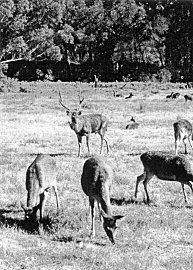 |
There are currently an estimated 700-800 deer in the Royal with numbers increasing each year. Parts of Royal National Park that were previously farmland are not regenerating naturally with shrubs and trees due to deer grazing.
The National Parks and Wildlife Service (NPWS) has a policy of removing feral animals and plants from national parks. Feral animals and plants compete with native species. They often compete very successfully because introduced species do not have biological controls that would exist in their country of origin to keep their numbers in check.
When NPWS tried to remove deer a few years ago, the outcry from some sectors of the community was intense and the program was halted. In 1997, the Minister for the Environment granted approval to commence a deer relocation program. Two areas in the Royal National Park have been chosen for the permanent installation of 50m x 50m enclosures. The areas have sufficient quantities of grass, shrubs and tree-cover to afford food and shelter. NPWS staff supplement the natural food with 'free-feeds' to encourage deer to enter. When the deer are feeding quietly in the enclosures the gates are closed on them. A settling period of twenty-four hours has been recommended and approved by deer handlers and RSPCA Inspectors. During this period it is crucial for the deer's welfare that they be left alone. NPWS staff regularly, but discretely, check the condition of the deer during this time. Relocation of the deer takes place at night by trained deer-handlers, NPWS and RSPCA staff. Quiet conditions are maintained throughout the operation. The transport vehicle, prepared with straw bedding and feed, is parked against the ramp of the enclosure. Two or three people enter the enclose and slowly direct the deer towards the ramp and into the truck. The deer are then taken to registered farms.
To the frustration of NPWS, people have been disturbing deer in the enclosures, sending them into a frenzy which have seen deer injure themselves against the sides of the enclosure. People have also been cutting holes in the enclosures to provide escape routes for the deer. It is difficult to understand what these vandals are seeking to achieve apart from mischief. It is unlikely that NPWS will be able to eliminate deer from the Royal National Park, but the relocation program potentially enables a reduction in the population of deer and a chance for native plants and animals to take a stronger hold on their own territory.
The deer in the Royal National Park are Javan Rusa Deer. They were introduced into Gundamaian Point on Port Hacking for hunting purposes. They escaped captivity and have reproduced to spread throughout the Royal National Park and the Illawarra.
They eat grassy vegetation and the soft growth of shrubs and small trees during dry times. Regeneration of plants after fires is greatly reduced by deer grazing, when all animals are in competition for food. Native grasslands in the coastal valleys are damaged by male deer ripping out tussocks with their antlers in practice for territorial fighting with other males. Trees are ring-barked by males rubbing off antler velvet during winter and spring. Private gardens and fencing are being damaged in areas adjoining known deer populations. Their hard hooves compact soil and lead to soil erosion and shifting of sand dunes.
To determine "acceptable" population levels, more research into the sensitivity and resistance of the Royal's native bushland and coastal valleys is planned. The research will include: accurate measurement and monitoring of deer impacts on native herbivores, andpopulation management methods including sterilisation and ground surveys to measure population levels and rates of increase. Jibbon Beach Toilets: A Comedy?
The Port Hacking Protection Society has been arguing for some time that one of the major factors inhibiting the proper management of Port Hacking is the plethora of Government Authorities involved who either can't, wont allow, or don't want to take cooperative action.
Management (poor management?) of Jibbon Beach (below) is a classic example of the mess that can arise from the unintegrated responsibilities of the Authorities. |
 |
You may remember that in previous issues of this newsletter, we have reported that there have been representations by several individuals and groups for the construction and maintenance of facilities to cater for the hundreds of people that visit Jibbon each week. Here is an extract from the Minutes of Sutherland Shire Council's Port Hacking Planning and Advisory Committee of how the issue is (not) being dealt with:
"Discussions took place on the need for the provision and maintenance of toilet facilities at Jibbon Beach, Bundeena. Jibbon Beach is located within the Royal National Park and as such Sutherland Shire Council does not have any obligation or requirement to provide or maintain any facilities or services, including toilet facilities." Council's only involvement in this issue to date has been by way of an offer to the NPWS for Council to input into the Plan of Management they propose to prepare for the area. To date Council's input has not been requested, nor has it been advised of the available funds for implementation of the project.
Unfortunately the matter has developed into an issue of land tenure and responsibility, between the NPWS and DLWC. The DLWC are responsible for the land between high and low mean water mark (the beach). The Bundeena District Progress Association and concerned community groups brought this matter to the attention of the Waterways Authority, NPWS and Council back in 1985, however no results have been achieved to date.....
(DLWC stated that) all Councils can perform subsidised work on such land and receive funding under the DLWC's coastal program or waterways program. It was noted that once the DLWC has contributed funds towards the capital expenditures required, the DLWC will have no further involvement in relation to maintenance. This will need to be provided by another agency. (NPWS) reiterated the importance of maintaining such facilities and ensuring adequate funds are available. The NPWS previously had a timber toilet at the north-eastern side of the beach which was burnt down.
(It) was suggested that the Waterways Authority should be responsible for some of the rubbish at Jibbon Beach as the Waterways collect charges for Waterways waste and it was possible to put a surcharge on moorings in order to fund facilities at this beach and reduce the impact of the user groups.
(It) was suggested that... the following organisations be involved in any future management of this area: Bundeena Precinct Committee NSW Fisheries Department of Land and Water Conservation Environment Protection Authority National Parks and Wildlife Service Waterways Authority Sydney Water Sutherland Shire Council Department of Sport & Recreation.
(It was) suggested that a central controlling authority such as Council or NPWS take care, control and management of the Crown Reserve at Jibbon Beach, however the issue of ongoing funding and maintenance of the site needs to be addressed. In relation to enforcement issues, it was noted that NPWS would have superior enforcement ability over Council. It will be necessary to form a sub-group consisting of the thirteen agencies, and have one of these agencies responsible for the ongoing maintenance. It may also be necessary to set up a trust account with contributions from all agencies, and then draw upon these funds for the long term maintenance of the facilities.
(Council Officer) advised that Council's assets are escalating with insufficient funds to resource them...."
And so it goes on. To date, the matter has not been resolved. Stop Press Grant Money for Community Groups
For the fourth year, the State Government has granted $30,000 to the Hacking River Catchment Committee (HRCMC) to fund community group projects within the Hacking River catchment. The money is for groups involved in the management or conservation of specific areas of land, water or vegetation within the catchment.
Community groups wishing to apply for funds should contact Libby Rawlingson, HRCMC Co-ordinator on (9895 7769) for details and application forms. Grants to individual groups are not to exceed $5,000 so that a wide range of projects can be funded and must show $ for $ contribution. This can, however, be "in-kind support" which could include voluntary labour.
In previous years money has gone towards providing the Helensburgh Landcare Group with equipment to conduct water quality testing in the upper catchment area, the Port Hacking Protection Society and National Park Association have received money for publishing a newsletter and conducting community biodiversity surveys, several Bushcare Groups have received assistance in addressing primary weeding.
Applications close on 9 April 1998. Seagrass Protection
The April 1997 Protectorate (issue 13) dealt extensively with seagrasses in Port Hacking and the importance of seagrasses.
To underscore their importance, NSW Fisheries has developed a Fish Habitat Protection Plan aimed at protecting seagrasses - an important fish habitat. The Protection Plan requires that permits be required from NSW Fisheries for the collection or trimming of live seagrass, for the collection of dead seagrass from oceanic or estuarine beaches for commercial purposes (more than 20 kg per day), dredging, reclamation of an area, construction of groynes and breakwaters, and construction of jetties, wharves, bridges, ramps and pontoons.
Applications to dredge, reclaim, construct over or through areas containing posidonia seagrass beds will generally not be approved. Application to conduct these activities over other forms of seagrasses may be permitted for an essential public purpose in the case of dredging (such as for navigation channels) and on a case by case basis for other forms of construction. Setting Environmental Objectives for Port Hacking
The NSW Government is in the process of setting water quality objectives for waterways. It will be seeking community input into setting those objectives through a series of community discussion meetings to be held throughout the State in February through to April.
The meeting for the Hacking River catchment will be held at Cronulla Bowling Club, 41 Croydon Street, CRONULLA, Tuesday, 31 March, 6:00 to 10:00. It will be opened by Peter Wells, Chairman of the Hacking River Catchment Management Committee.
Environmental objectives focus on two key factors for river health - water quality and river flow. The process for setting the factors is based on the discussion paper, Proposed Interim Environmental Objectives for NSW Waters, released late last years for six months public consultation.
The meetings are open to everyone. The Government wants to know what you want to use your waterways for and what value you place on them:
-
Are you happy with the way things are in your part of the catchment and what things do you want to see changed?
-
What level of water quality do you need for your use of the Hacking?
-
Do you need to use your local river or creek for swimming, or for watering livestock, or for sailing or for water for irrigation, or fishing?
Sediment Control from Construction Sites
A recent survey by Sutherland Shire Council of construction sites showed that 59% of sites still have inadequate erosion and sediment controls in place. Eighteen percent of sites had no controls at all.
While still inadequate, the compliance rate is an improvement from results of a survey in 1996 which showed that 78% of construction sites had inadequate controls. To achieve the increased compliance rates, Sutherland Shire Council has distributed information on erosion and sediment control requirements for construction sites and has included inspection of these controls as part of the duties of building surveyors and engineers.
It appears that when inspections are not anticipated by those carrying out the construction work, the erosion and sediment controls are allowed to deteriorate and only repaired or maintained when another inspection is anticipated. There is also a problem with maintenance of controls when construction has finished but landscaping to stabilise the site is not yet completed.
Construction sites without or with poorly maintained erosion and sediment controls introduce tonnes of sediment into the Shire's waterway. The siltation at the head of many bays in Port Hacking is directly attributable to construction activities in the catchment area. Sutherland Shire Council is currently investigating measures to further improve compliance rates, including improved delegation for enforcing controls, training for those involved in the construction industry and the introduction of other educational aids. The Council is also working with other councils in the Southern Sydney Regional Organisation of Councils' area to develop a regional approach to erosion and sediment control. |
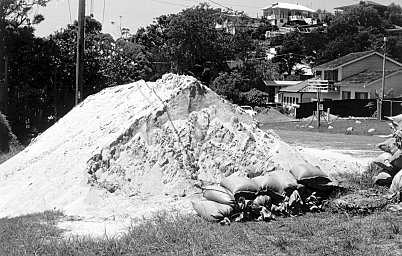 |
And the Rubbish Piles Up - Cawley Road
Remember in August and in December last year, we reported in the Protectorate on the problem of rubbish dumping at Cawley Road?
Over six weekends last year, volunteers from the Helensburgh and District Landcare Group and Wollongong City Council "dragged and bagged" rubbish to the side of Cawley Road. Fifteen to twenty tonnes of rubbish were collected by Wollongong City Council, and seven large trailer loads of metal was removed for recycling. Other material required a front-end loader. The Department of Land and Water Conservation (DLWC), who have responsibility for the road, undertook to remove this.
There were strong representations to have the road closed but, after public consultation on the issue of road closure, DLWC decided against this.
Rubbish is still being illegally dumped. Recently, 69 twenty litre drums of cooking oil, some of them leaking, were dumped. The drums pose a hazard for fire fighters in the event of a bush fire in the area. In fact, the rubbish dumping has become so bad that the Rural Fire Service has difficulty driving on the fire trails.
In an effort to solve the dumping problem, the Hacking River Catchment Management Committee convened a meeting of relevant stakeholders: EPA, Wollongong Council, Helensburgh and District Landcare Group, Illawarra Waste Management, Transgrid, Railways Services Authority, Forest Mushrooms, NPWS, DLWC and the Parliamentary Secretary for Emergency Services, Ian McManus.
The meeting decided to call for public help to report instances of dumping and to erect a gate at Cawley Road to limit access. Installation of the gate is to be accompanied by letterboxing all residents to explain why. Representations from residents will be taken into account. DLWC wishes to ensure that all those who require access have the means to do so. The Illawarra Waste Board will also liaise with its constituent Councils to develop an education campaign on illegal dumping.
In the past month, one person has been caught dumping rubbish, has been told to clean it up and has been fined. The likelihood is that a second person will be similarly dealt with soon.
Keep your eyes on Cawley Road. If you see someone dumping, call the EPA's Pollution Line on 131555 and report the dumping. If you know the person, tell them to "wise" up, and Keep Cawley Road clean and green!
BioDiversity Surveys Continuing |
 |
When you stand on the swaying deck of a ferry which is putt-putting slowly up North-West Arm past a foreshore lined with graceful angopheras, past mullet jumping out of clear waters, past patterns in sandstone rock that defy an artist's imagination, while white cocatoos dance and wheel against a clear blue sky, and the man you are speaking to gets a far-away dreamy look as he talks about fungi, you know you are speaking to someone who is seriously in love.
The man is Allan House from the Hacking River Catchment Management Committee. Fungi, he tells me, tenderly cradling the image in his mind of these mostly obscure life forms, are a very important component of biodiversity. If you can't find fungi in the bush, the bush is not healthy. They are an integral part of the food chain. Together with bacteria, fungi are responsible for the disintegration of organic matter and the release, into the soil or atmosphere, of the carbon, oxygen, nitrogen and phosphorus that otherwise would be forever locked up in undecomposed organic matter. |
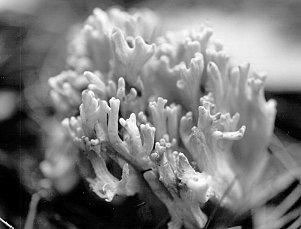  |
| I was instructed chapter and verse on the role of fungi that day. I was told that management authorities such as National Parks and Wildlife Authority are coming to terms with the importance of fungi and the need to consider fungi in ecology management programs. To implement management programs, of course, it is important to understand where and which and why fungi are. |
 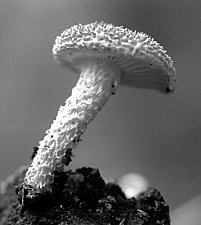 |
| A band of volunteers and experts recently undertook a training program and began the task of identifying the diversity of fungi in the Hacking catchment on an ongoing basis. |
 |
They mark out one metre square quadrants and count flowering heads of the fungi (for many fungi, this is the only part that you can readily see). They note the species of fungi in the quadrants, the characteristics, location, weather, etc., and they take samples (though apparently the preservation of samples is a problem because fungi are mostly full of water. Once they dry out they become meaningless, shriveled, brown bits of "stuff"). The quadrants are re-surveyed on a regular basis.
The love of water that fungi have, my informant noted with a grimace, is why no fungi surveys have been carried out this year. Most fungi only flower after a consistent fall of rain. This summer (1997/98) hasn't seen much rain.
The fungi survey is only one of several surveys being conducted by the Biodiversity Working Group coordinated by the HRCMC (and reported on in Protectorate 15). After the 1994 bushfires, National Parks and Wildlife Authority contracted researchers from universities to conduct surveys in the Royal National Park. With the establishment of the HRCMC Biodiversity Working Group, there was a greater capacity to involve the community. Over 150 people have now offered their services and have undertaken training to enable them to survey plants, frogs and reptiles, birds, or fungi.
Surveys have also been recently completed for reptiles and frogs, and for plants. The reptile survey was conducted over two days and two nights in both the Royal National Park and in North Cronulla. Volunteers observed a high number of skinks and dragons, three species of snakes and six species of frogs including the rare and endangered Green and Golden Bell Frog. |
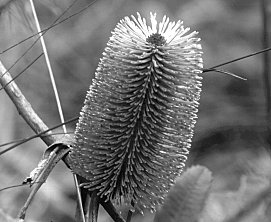  |
The plants were surveyed in quadrants of 20 metres by 20 meters by 15 trained volunteers at three sites in the Royal National Park and three sites in the Heathcote National Park. Volunteers identified between 36 to 65 plants in each quadrant. No weed species were found in the Heathcote sites and approximately five weed species were found in the sites located in the Royal National Park.
Engadine Wetlands
Following the successful operation of a wetland at the headwaters of Engadine Creek, Engadine in 1995, Sutherland Shire Council proposes to build another wetland at the main stormwater outlet opposite Mianga Avenue, Engadine.
Last year, Sutherland Shire council tested stormwater quality from the outlet and found it to have high levels of lead and nitrates, as well as a range of nutrients. The catchment for the stormwater has a mix of light industry, commercial and residential uses.
A gross pollutant trap has already been constructed at the upstream end of the proposed wetland. Together with the constructed wetland, the aim is to collect all sediment, heavy metals and nutrients etc, and reduce the impact of these pollutants on Engadine Creek in the Royal National Park as well as the Hacking River.
The wetland's estimated construction cost is $108,000. Half ($54,000) of the cost will be met through a grant provided by the state government's Rivercare Program. The other half of the funding will come from Sutherland Shire Council. |
 |
Wetlands, though very effective at treating polluted waters, are complex, living structures. They are vulnerable to degradation unless maintained. Sutherland Shire Council carries out monthly inspections of its already constructed wetland, inspecting the stability of structures, erosion, water level, outlets and gross pollutant traps for debris and litter. They also check the health of the flora, being especially vigilant against invasive and destructive weed species such as alligator weed. As well as monthly inspections, wetland specialists carry out an annual inspection. These annual inspections are a more in-depth assessment of the wetland's ecology and effectiveness. They cover such concerns as: numbers of species of plants available - percentage of desirable native species, percentage of undesirable species; substrata assessment and whether structural repairs of aspects of the wetland are required; litter and debris present; hydrology; mosquito risk; water quality and clarity; type of fauna and desirability of fauna species present.
This type of maintenance program will also be carried out for the second wetland at Engadine.
A number of schools in the Shire have taken up Sutherland Shire Council's invitation for students to visit the wetland and learn about the problems associated with stormwater pollution and the function of constructed wetlands. Students and teachers were given a one-hour "talk and walk" tour which provided instruction on the identification of weed species, litter and water quality monitoring, birds and other fauna inhabiting the wetlands.
Schools wishing to know more about wetlands or participate in environmental projects should contact Mr Mike Rogers, Council's Stormwater Management Engineer on Ph 97100484, or the Environmental Science and Policy Unit on 97100463
Whats Happening to the Hacking?
by Paul Martin
For the many thousands of people who enjoy or have enjoyed the Royal National Park, the Hacking River and the ocean shores are a pivotal ecological resources, and central to their experiences and memories. Many of us are aware of the sad history of the loss of the platypus, and of the threats posed by foreshore development of the estuary. But beyond these obvious factors, and the obvious beauty of the river and estuary, what is happening to the Hacking?
The assessment of the Hacking provided in the 1998 Department of Lands and Water Conservation draft Water Quality Guidelines for NSW Rivers notes that the water is contaminated throughout the upper reaches of the Hacking through to the estuary itself. But state government policy changes (as yet un-implemented) and active and committed individuals (as yet under-resourced and largely unrecognised) provide the seeds of hope to change this situation.
Ultimately to change the situation, resources are required. If resources continue to go almost entirely to the promotion of the things that are causing the problems, and little into preventing or managing the problems, then the outcome will be distressing.
Pollutants in the Hacking
The most significant source of pollutants is sewerage, with the most obvious point of discharge being the Cronulla sewerage plant into Bate Bay. But there are other sources of this pollutant: The many un-maintained septic systems in the upper catchment, Bundeena and Maianbar, and some areas on the Northern side of the Port; The less apparent impact of licensed sewerage overflow points (with an estimated 1,708,000m3 of sewerage entering Port Hacking , and 15,100 m3 above Audley Weir each year, from Sydney Water licensed discharges); The unquantified problem of sewerage discharged from boats.
Other sources of pollution come from the unquantified wastes from animals - for example large duck populations around Audley, horses in the upper catchment, and from the Symbio site; Phosphorus and nitrates from urban areas (to illustrate; the 1996 Yowie Bay Process Study produced by the consultants Patterson Britton & Partners reported that since 1950, an estimated 100,000 kg of total phosphorus and 270,000 kg of total nitrogen has entered Port Hacking from the Yowie Bay catchment alone); Leachate from tipsites and old night soil storages in the upper catchment; Runoff from urban areas.
Sediment
The impact on Port Hacking of land-based development without proper sediment control is illustrated by the problems experienced in Yowie Bay. The head of the Bay is now largely a shoaled and muddy swamp-plain, where not more than 20 years ago it was a pristine and navigable estuary. Unfortunately this is not a problem that is likely to go away in the lower catchment, as the relevant authorities are slow to require that all construction sites have proper sediment controls. Sediment also comes from erosion associated with horse farms and feral animals. Encouragingly some property owners and relevant authorities are working together to reduce the problem.
The most frequently debated issue: sand which causes navigational problems form some Port users, is probably the least significant concern from an ecological viewpoint. For many recreators, the shoaled nature of the Port is an important contributor to its recreational appeal. Neverthelss, this issue attracts the lion's share of the sediment management investment in the Hacking catchment!
Biodiversity
There are probably more critical biodiversity concerns for the estuary itself than for the river. In the estuary, the impact of boating on the irreplaceable posidonia seagrass beds are apparent from aerial photographs. A walk along the shoreline shows almost denuded rock shelves as well as fishing related trash, knotted line, hooks and the like).
Equity and use
Bonnie Vale, Jibbon, Audley and The Basin are all areas where issues of recreational use and management of the Royal National Park intersect. In all cases there are major issues of equity and sustainable use that are not being addressed. At Bonnie Vale, use of an informal boat ramp by powered vessels and a failure to properly manage the area is reducing the enjoyment of the low key users (swimmers, picnickers, fishers, and the like); At Jibbon, the absence of facilities and effective management is resulting in conflicts, and a health threat from toilet wastes; At Audley, the facilities are controlled by commercial operators, raising issues of the proper and equitable use of national parks; The Basin, a truly remarkable place, is increasingly seeing the presence of high speed power craft which disturb other users who come to the area to enjoy its peacefulness.
What is happening about these issues?
The most significant thing that is happening is community action, with heroes like Allan House, Chris Wilmott, Tim Tapsell, the National Parks Association and the like showing a sustained commitment to overcoming problems that are increasingly evident. In the lower Hacking, others like George Cotis, Alberto Albani and the Port Hacking Protection Society, keep up the pressure for protection and rectification. The Hacking River Catchment Management Committee has put forward plans for the sustainable management of the estuary, and for correction of the identified pollution sources. It intends to conduct a public forum later this year, at which the various government authorities will be required to account to the community for what they are doing and what they propose to do. Perhaps this might be a way to get some long delayed action to look after the river and the estuary that we value?
Dear Editor - By Phone
Jetskis, PWCs, tinnies and the like
A grateful caller from Maianbar rang to tell us that this summer she has enjoyed relative peace from noisy watercraft. She has spoken to the Waterways Authority and congratulated their boating officer on restoring order to the area.
This is good news indeed! and has been echoed by other comments made by people around Port Hacking. We contacted the Waterways Authority Office. They told us that this summer they have instituted a range of measures that have made the difference. One of these is the Jet ski free zone off Darook Park. Jet skis are banned from the 500 metres of shoreline in front of Darook Park and within 120 metres of the shore. PWCs have also been told by Waterways Authority to keep their distance (see box). As well, PWC drives are now required to obtain photo licences. This requirement was stipulated in 1997 but drivers were give 12 months to upgrade their normal boating licence. As a condition of their photo licence, each PWC driver has to attend a seminar on rules and regulations on the waterways and appropriate behaviour. The Waterways Authority has also cooperated with PWC manufacturers in producing a video on water safety issues which is supplied to all new PWC owners and a video has been sent to all PWC owners on the Waterway's Authority database. A team of "Ride Smart" officers patrol Port Hacking to ensure that PWC drivers are not "misbehaving". During the course of this summer, the officers have booked or cautioned many PWC drivers. |
A PWC when travelling at 10 knots of more is not permitted within 60 metres of:
any person in the water or a non-motorised watercraft
OR within 30 metres of: any vessel, any pile or structure, river bank or shore, jetty, landing stage, pontoon or pump inlet.
If a PWC driver cannot maintain these minimum safety distances, they must slow down to less than 10 knots. |
|
 |
An outraged PHPS member rang to tell us that the behaviour of PWC drivers at Bonnie Vale and in Simpsons Bay was beyond a joke! He said he saw a group of PWC drivers weaving in and out among children swimming and riding their surf Boards just off Bonnie Vale Beach. The children were swamped by turbulence from the PWC and a number of them obviously frightened. A parent confronted the PWC drivers, asking them to leave the children alone and was abused by the drivers. The PHPS member backed up the parent's demands and was in turn threatened with physical violence. When the PHPS member tried to contact Waterways Authority, the office was closed and there appeared to be no access to someone of authority to stop the dangerous behaviour of the PWC drivers.
Obviously, while some gains have been made in relation to control of PWCs in Port Hacking, there is still some way to go. We were particularly concerned to hear of this incident because earlier in the year a child had been injured by a PWC at Bonnie Vale. PHPS continues to lobby for better management of PWCs, not only with regard to dangerous behaviour, but also with control of excessive and persistent noise. If you need to contact Waterways Authority to report an incident or dangerous behaviour, call 9563856. This number is for the main control centre of Waterways Authority and operates from 8.30 to 4.30 seven days a week. All phone calls are logged and the caller's name recorded. We encourage anyone who sees dangerous behaviour by vessels on Port Hacking to make a complaint to this office, whether or not you have licence details of the vessel in question, so that Waterways Authority can gauge the nature and location of problems in Port Hacking. |
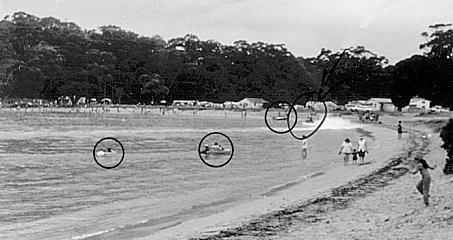
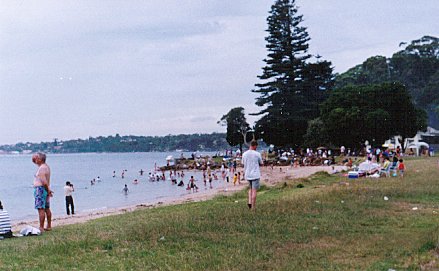
|
Cawley Road
A Protectorate reader rang to say he had seen a truck laden with rubbish on the Princes Highway driving South through Engadine and past the Heathcote Road turnoff. The truck returned sometime later without its load. The caller surmised the rubbish had been dumped at Cawley Road. Unfortunately the caller was unable to provide details about the truck, licence plate number and the like. See the item on rubbish dumping at Cawley Road in this issue. The rubbish dumping is becoming a serious matter and if you do see someone dumping in the area, please call EPA's Pollution Line on 131555 and make a report. Remember to give details so they can trace the dumper!
Fishing and Bilge Water in Port Hacking
A caller contacted PHPS to voice concern regarding netting of fish off Salmon Haul Bay by commercial fishermen. The caller also said that she saw a tanker moored not more than two kilometres offshore pumping out bilge water for two days and was this a problem.
We contacted NSW Fisheries regarding commercial fishing off Salmon haul Bay. They responded by telling us that commercial fishing was allowed in Port Hacking within limits. We've reproduced some of the information they provided us in the box below.
The issue of bilge water and what problems it poses for Port Hacking is a vexed one. PHPS has had a long-term concern about this issue and tried to encourage some form of control and action to safeguard the Port, but so far, safeguards have not been put into place. The Australian Quarantine and Inspection Service (AQIS) has suggested a range of voluntary guidelines for ships entering Australian waters. AQIS is now seeking international agreement for mandatory regulations for control of ballast water intakes and discharges. We will provide more information on the issue of bilge water in the next issue of the Protectorate. In the meantime, if you are interested in participating in a community monitoring program aimed at increasing community awareness of marine pests, contact Karen Parsons (Ph. 03 6232 5129, email Karen.Parsons@marine.csiro.au). |
Commercial fishing in Port Hacking
All of Port Hacking is currently subject to some form of commercial netting regulations, whether it be areas closures or gear restrictions. All waters west of a line drawn from Hungry Point on Cronulla Peninsula, southerly to Cabbage Tree Point are closed to all forms of commercial netting, and some forms of recreational prawn nets. The only methods permitted here are the dip or scoop net (a recreational prawn net), the landing net (when used as an ancillary aid to line fishing) and the bait trap. All waters of Port Hacking west of a line drawn from Glashier Point in a south-easterly direction to Port Hacking Point are closed to spearfishing.
No commercial fishing is allowed on weekends and public holidays for waters of Salmon Haul Bay. From 6 am Saturday to 6 am Monday in each week, and from 6 am to 6 pm on any public holiday, only recreational prawn nets are allowed in waters north of a line from Hungry point to the foreshore adjacent to the Bass and Flinders Memorial.
Waters of Gunnamatta Bay (north of a line from Burraneer to Hungry Point) are closed to the taking of worms, nippers and shellfish (invertebrates) by all methods. All others waters of Port Hacking are open to bait collecting by lawful methods.
Waters of Port Hacking which are east (seawards) of the line from Hungry Point to Cabbage Tree Point are traditional commercial hauling grounds. Commercial fishers are permitted to use hauling nets for targeting mullet and other fish all year (except during weekends in the months of November, December, January and February). Garfish nets (bullringing) are also permitted except during December and January.
NSW Fisheries is in the process of developing a management plan for commercial fishing in estuaries. The estuary general management plan will be developed with representatives from the commercial industry, fisheries scientists, recreational conservation and indigenous groups.
Contact the local District Fisheries Officer at Sans Souci Fisheries Office on 02 9529 6021 if you require further information. |
|
Dear Editor - By Letter
Dear Editor,
Today I received your Port Hacking Protectorate and was surprised to see your story on Helensburgh Colliery. I am a coalminer's wife and this town (which I have lived in all my life) was started mainly because of the Pit. I am sick and tired of reading and hearing what "impact" it is doing to the environment. Those men have been fighting for their and our livelihood for quite some time now and the management is doing everything they can to prevent any damage that may occur. They have spent a lot of money improving that situation and it is a far cry from the conditions it was 10 years ago. These men who work there also contribute to local youth and sporting groups for the benefit of children.
We, in this society think we are doing the right thing for the environment and it all starts at home. Plastic bags, jars and rubbish that comes from the home can be found on the side of roads, in the bush and in our waterway. Syringes and condoms can be found in our parks, beaches and eventually in the ocean. Our coalminers and management are doing everything possible to keep my Helensburgh a beautiful place to live in.
"Have a heart!" Anonymous
Dear Editor,
Thanks for the great wrap you gave Bushcare in the December Protectorate.
Sutherland Shire Council Bushcare now boasts over 900 registered volunteers working in some 80 public remnant bushland reserves.
We also run a comprehensive training program outside regular group work days in the form of a two day course called "Introduction to Bush Regeneration". This course is taught by "yours truly" and happens quarterly on the first two Saturdays of February, May, August and November each year. The venue for these training sessions is the Council Training Centre at Ethel Road, Kirrawee. Anyone interested in doing volunteer bush regeneration is welcome to come along. Details of the course can be obtained from the Bushcare Office.
Bushcare has a direct telephone line into Council which is 9710 0192.
R Rogers - Sutherland Shire Council
Swimming Port Hacking - The Harold Holt Phenominom
We received this rather long letter from a Protectorate reader (group?) and avid non-motorised user of Port Hacking. The letter covers a couple of topics that the Protectorate also deals with (though not with the same degree of whimsy as this letter writer indulges in). The letter was very long and we have edited it slightly, but not reduced its content.
A mere toddler among the ranks of Port Hacking based recreational "Organisations", the not quite four-year old outfit calling itself the "Harold Hold Swim Club", seems to be netting a steady stream of interest in its activities if the size of recent shoals seen frequenting the bays and waterways of Port Hacking is anything to go by.
The spectacle of 30 to 40 human beings swimming in close school formation across a body of water is a moving sight in the most literal sense of the word, for moving from point A to point B around the Port Hacking waterway is exactly what this easily misunderstood mob is so busy doing with itself on calendared public swim events that accrue on average once a fortnight between November and April.
Vastly different from traditional swimming club fare, a "Harold Holt Swim" is a community-access iron person event. Participants who think they can go an advertised distance over a designated route simply turn up at the group swim event's bill-posted starting place. Twenty-four public group swim events held since 1994 have turned up a licorice allsort variety of different age, sex, and physical body types, these ranging from serious, trans-English Channel veterans, to municipal pool lap victims seizing a more adventurous escape from their daily fitness rituals. |
 |
"Critical mass" for an intoxicating group swim event can be a gathering at the place of embarkation of as few as two or three willing participants - weather permitting or not! On most occasions though, groups of twenty meet at shoreline locations to make passage.
Though some reach regular breakneck speeds, the majority flock together in a sociable coterie of mixed swimming styles, the "school" (of humans, not fish), invariably maintaining a manageable, non-sprint-event speed bolstered with the additional psychological comfort of safety in numbers, (statistically anyway, one's numerical chances of surviving adversity are greatly enhanced in a crowd. What are friends for?)
One of the more popular swim events on the club's annual "school formation" calendar, is the annual "Red Sea crossing" of Port Hacking, held at the moment of the year's lowest tide, (when participants can literally walk-on-water a kilometre into the middle of mis-named, ankle depth Port Hacking).
Another favourite among Port Hacking's southern shoreline denizens is the annual "Bundeena Commuter's special" - a swim across the waterway's tightest confine between the far northern end of the Simpsons Bay sandspit, and the foreshore at the end of Woolooware Road on the Burraneer Peninsula. This short-on-distance, but big-on-bravado technical crossing of Port Hacking, leaves this year from the same location, at 4 pm, Saturday, March 28th. (Northern shorelines should congregate at the bottom of Woolooware Road at the same time for a North-South crossing that might cross paths with the southerners heading north at the exact same time). Opposite shores reached, we swim back to our places of departure.
There are no phone numbers to ring, no bookings to be made. Just turn up and get wet if any of the following club non-liabilities don't dissuade you from the comfort of hiding in a crowd:
-
The however small possibility of being tasted by a sexist, man-eating, mindless omnivore
-
The preferable remote likelihood of being face-to-face with stinging, gelatinous horrors that just want to wrap their tentacles around you
-
The every-present risk of being eight-balled by some leached mindset lawnmowering the Port on his P WC (Powered Water Closet)
-
The long-term exposure prospect of being poisoned by re-combinant marine and terrestrial pollutants and runoff
-
The opportunity for international travel from being blamelessly but miscalculatedly, swept out to sea
On the subject of Port Hacking's not yet shaken or stirred cocktail of steadily accruing urban runoff, the Harold Holt Swim Club, (a Club without premises, but not premise), owes a mighty vote of thanks to one organisation that is really out there and doing its own level best to promote and provide just the kind of tightrope swim training conditions that an outfit like the HHSC really needs if the group's year 2000 Olympic Games aspirations are to be met.
Not enough can be said about the unsurpassed supporting role played by our very own Sutherland Shire Council in its daily and ongoing mega-dosage of Port Hacking's unrealistically-pristine habitat, with mild but consistently-applied, assorted batches of re-combinative, degradable herbicidal chemistry sprayed generously along nature strips, road verges, and kerb edges, right around the catchment! Even the tamest of street tree plantings get their regular doughnut-shaped dose of deadened brown grass and loosened topsoil to contribute toward our waterway's appreciatively growing siltation load.
The Harold Holt swim group's Olympic training couldn't be more nurturatively fostered: each and every day we know there's a tiny but reliable quota of poisoned plant nutrients, half-life residues of commercial weedicide, and even a spade or two of liberated soil and silt, all of it there just waiting for the usual light rain, or daily hosing down of 200,000 driveways, to make its way downstream to unsuspecting Port Hacking where re-assembled in Jamboree proportions as a fascinating tonic of multi-afflictive possibilities, the brew can go about its automatic business of concentrating new toxicities, smothering established marine flora and fauna, and force-feeding more desirable blooms of fertilisable species.
And what a smart little addition to Jibbon Beach we've been gifted with so recently. A "surprise" installed in little Jibbon Creek valley in Bundeena. Who would ever have thought that a modest municipal authority could still convert a creek easement into an unrestrained and unvegetated stormwater pipeline, in Sydney, in 1998, and pipe it directly onto one of the city's, (and Port Hacking's), most beautiful and popular beaches?! Thank you again SSC, not only do you consistently brew us the kind of summary swimming conditions we'll need to face if we're to tackle Homebush Bay in practised condition, you've even expedited its arrival in Port Hacking for us! At Jibbon Beach nonetheless! A quarter of a town's unretarded septic leachate as well!
The Harold Holt Swim Club is a "Club" without premises, we meet in the water. See you there, (at 4 pm, at the far end of the Simpson's Bay sandspit, on Saturday March 28), if you dare.
Extracted from "Home truths versus half truths - A history of environmental posturing and post-humous point scoring by Local Governments and remote politicians anywhere, in relation to the steadfast ecological decay of watersheds everywhere". (Published by the "Harold Holt Home Page", 95231567) |
| top of page |
|



